Nigel S., Chambers S., Johnson R. Operations Management
Подождите немного. Документ загружается.

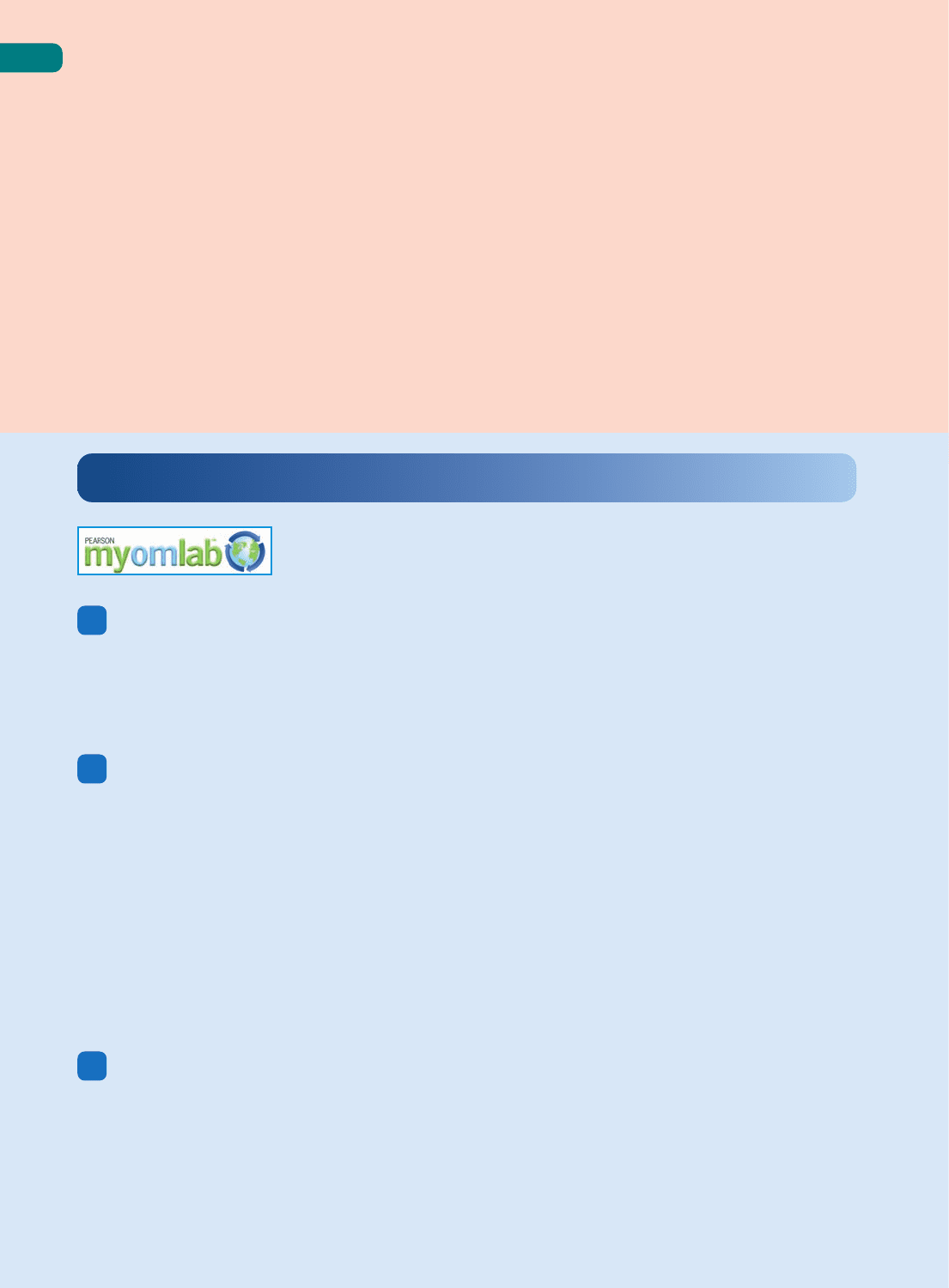
store stockroom, within H&M referred to as ‘Call-Off ware-
house’ replenishes stores on item level according to what
is selling.
Retail
All H&M stores (average size, 1,300 square metres) are
owned and solely run by H&M. The aim is to ‘create a com-
fortable and inspiring atmosphere in the store that makes
it simple for customers to find what they want and to feel
at home’. This is similar to Zara stores, although they tend
to be smaller (average size, 800 square metres). Perhaps
the most remarkable characteristic of Zara stores is that
garments rarely stay in the store for longer than 2 weeks.
Because product designs are often not repeated and are
produced in relatively small batches, the range of garments
displayed in the store can change radically every two or
three weeks. This encourages customers both to avoid
delaying a purchase and to revisit the store frequently.
Since 2000 Benetton has been reshaping its retail
operations. At one time the vast majority of Benetton retail
outlets were small shops run by third parties. Now these
small stores have been joined by several, Benetton-owned
and -operated, larger stores (1,500 to 3,000 square metres).
These mega-stores can display the whole range of Benetton
products and reinforce the Benetton shopping experience.
Question
Compare and contrast the approaches taken by H&M,
Benetton and Zara to managing their supply chains.
Part Three Planning and control
404
These problems and applications will help to improve your analysis of operations. You
can find more practice problems as well as worked examples and guided solutions on
MyOMLab at
www.myomlab.com.
‘Look, why should we waste our time dealing with suppliers who can merely deliver good product, on time, and
in full? There are any number of suppliers who can do that. What we are interested in is developing a set of
suppliers who will be able to supply us with suitable components for the generation of products that comes
after the next products we launch. It’s the underlying capability of suppliers that we are really interested in.’
(a) Devise a set of criteria that this manager could use to evaluate alternative suppliers.
(b) Suggest ways in which she could determine how to weight each criterion.
Three managers are attending a seminar on ‘Getting More Value from Your Purchasing Function’. One manager
is from a large retail bank, one is from a general hospital and the third is from a printing company. At the
seminar they were discussing their problems during coffee.
‘This is really useful; I think that even a relatively small reduction in our bought-in supplies bill could have a major
impact on the profitability of our printing company.’
‘Yes, I agree the hospital will also benefit from an exercise that would reduce the bought-in supplies bill. At the
moment it accounts for almost 30 per cent of all our expenditure.’
‘Yes, at the bank we spend almost 20 per cent of our expenditure on bought-in supplies. Given that our profit
is 20 per cent of our total revenue, any saving in bought-in supplies would be valuable.’
‘I have to say that profits are not so high in the printing industry. Our profits are only 10 per cent of sales
revenue. However, with bought-in supplies accounting for 70 per cent of our total costs, I am sure that any
reduction in bought-in supplies costs will be useful.’
Which of these three managers would benefit most from a 5 per cent reduction in their bought-in supplies bill?
The example of the bullwhip effect shown in Table 13.4 shows how a simple 5 per cent reduction in demand
at the end of supply chain causes fluctuations that increase in severity the further back an operation is placed
in the chain.
(a) Using the same logic and the same rules (i.e. all operations keep one period’s inventory), what would the effect
on the chain be if demand fluctuated period by period between 100 and 95? That is, period 1 has a demand
of 100, period 2 has a demand of 95, period 3 a demand of 100, period 4 a demand of 95, and so on?
(b) What happens if all operations in the supply chain decided to keep only half of the period’s demand as inventory?
3
2
1
Problems and applications
M13_SLAC0460_06_SE_C13.QXD 10/20/09 9:46 Page 404
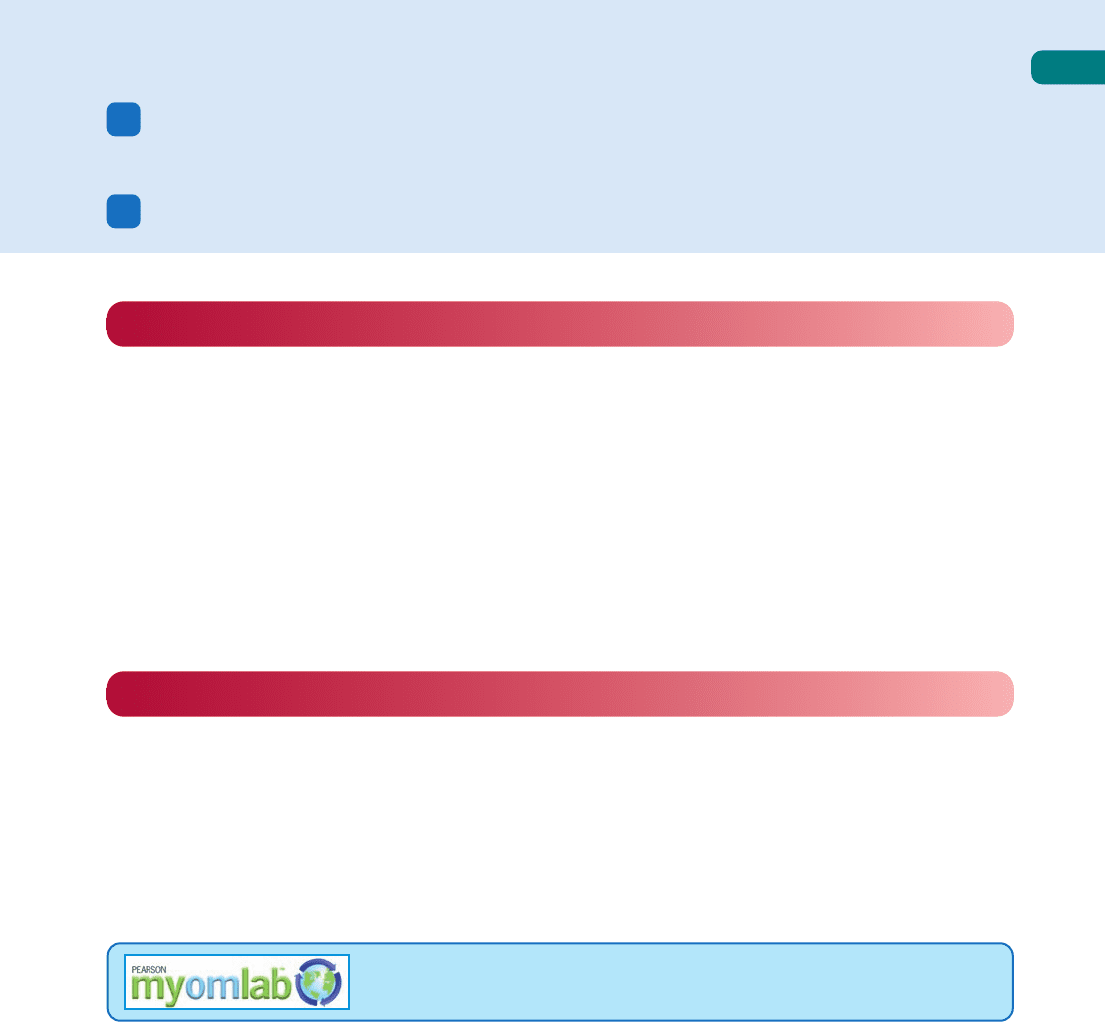
If you were the owner of a small local retail shop, what criteria would you use to select suppliers for the goods
which you wish to stock in your shop? Visit three shops which are local to you and ask the owners how they
select their suppliers. In what way were their answers different from what you thought they might be?
Visit a C2C auction site (for example eBay) and analyse the function of the site in terms of the way it facilitates
transactions. What does such a site have to get right to be successful?
5
4
Chapter 13 Supply chain planning and control
405
Andersen, M. and Skjoett-Larsen, T. (2009) Corporate social
responsibility in global supply chains, Supply Chain
Management: An International Journal, vol. 14, issue 2,
75–86. A good review of the topic.
Christopher, M. (2004) Logistics and Supply Chain Manage-
ment: Creating Value-adding Networks, Financial Times
Prentice Hall, Harlow. Updated version of a classic that
gives a comprehensive treatment on supply chain manage-
ment from a distribution perspective by one of the gurus
of supply chain management.
Fisher, M.L. (1997) What is the right supply chain for
your product?, Harvard Business Review, vol. 75, no. 2.
A particularly influential article that explores the issue of
how supply chains are not all the same.
Green, K.W. Jr, Whitten, D. and Inman, R.A. (2008) The
impact of logistics performance on organizational perform-
ance in a supply chain context, Supply Chain Management:
An International Journal, vol. 13, issue 4, 317–27. What it
says in the title.
Harrison, A. and van Hoek, R. (2002) Logistics Management
and Strategy, Financial Times Prentice Hall, Harlow. A
short but readable book that explains many of the modern
ideas in supply chain management including lean supply
chains and agile supply chains.
Selected further reading
www.cio.com/research/scm/edit/012202_scm Site of CIO’s
Supply Chain Management Research Center. Topics include
procurement and fulfilment, with case studies.
www.stanford.edu/group/scforum/ Stanford University’s
supply chain forum. Interesting debate.
www.rfidc.com/ Site of the RFID Centre that contains RFID
demonstrations and articles to download.
www.spychips.com/ Vehemently anti-RFID site. If you want
to understand the nature of some activists’ concern over
RFID, this site provides the arguments.
www.cips.org/ The Chartered Institute of Purchasing and
Supply (CIPS) is an international organization, serving the
purchasing and supply profession and dedicated to pro-
moting best practice. Some good links.
www.opsman.org Lots of useful stuff.
Useful web sites
Now that you have finished reading this chapter, why not visit MyOMLab at
www.myomlab.com where you’ll find more learning resources to help you
make the most of your studies and get a better grade?
M13_SLAC0460_06_SE_C13.QXD 10/20/09 9:46 Page 405
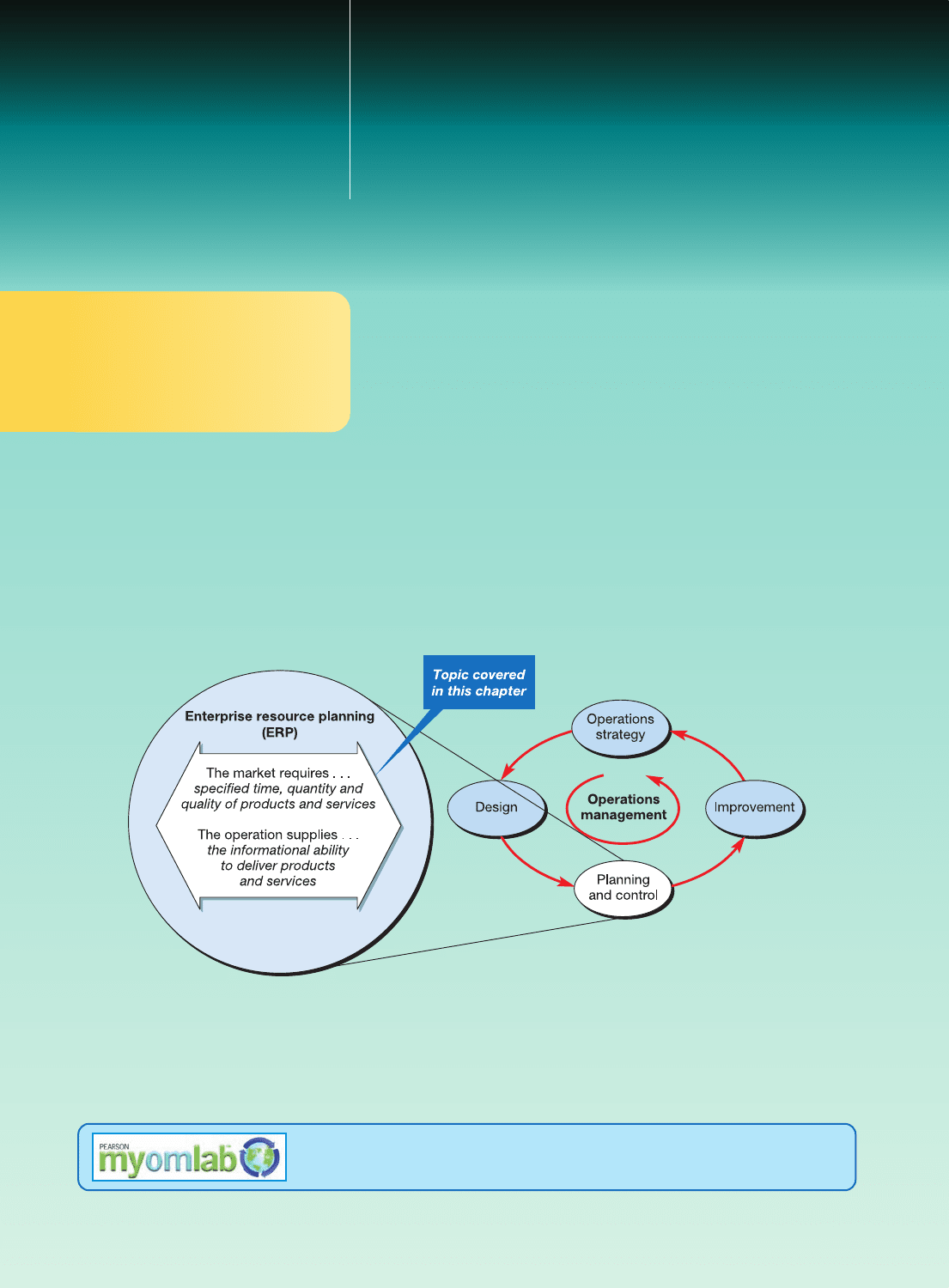
Introduction
One of the most important issues in planning and controlling
operations is managing the sometimes vast amounts of
information generated by the activity. It is not just the operations
function that is the author and recipient of this information –
almost every other function of a business will be involved. So, it is
important that all relevant information that is spread throughout
the organization is brought together. Then it can inform planning
and control decisions such as when activities should take place,
where they should happen, who should be doing them, how much
capacity will be needed, and so on. This is what enterprise
resource planning (ERP) does. It grew out of a set of calculations
known as material requirements planning (MRP), which is
described in the supplement to this chapter.
Chapter 14
Enterprise resource
planning (ERP)
Key questions
➤ What is ERP?
➤ How did ERP develop?
➤ How should ERP systems be
implemented?
Figure 14.1 This chapter covers enterprise resource planning (ERP)
Check and improve your understanding of this chapter using self assessment
questions and a personalised study plan, audio and video downloads, and an
eBook – all at www.myomlab.com.
M14A_SLAC0460_06_SE_C14A.QXD 10/20/09 9:46 Page 406

Rolls-Royce is one of the world’s largest manufacturers
of the gas turbines that are used to propel civil aircraft,
military aircraft and ships, and in power generation
as well as many other uses. They are exceptionally
complex products, typically with around 25,000 parts,
and hundreds of assemblies and sub-assemblies, and
their production is equally complex, with over 600
external suppliers and thousands of work centres in
many different locations. This makes planning a complex
task, which is why Rolls-Royce was one of the earliest
users of computers to help with the task. Traditionally
the company had developed its own software; however,
this had become increasingly expensive compared
with buying off-the-shelf systems. It was also risky
because customized and complex software could be
difficult to update and often could not exchange or
share data. So, the company decided to implement a
standard ‘enterprise resource planning’ (ERP) system
from the market-leading German SAP company.
Because it was a ‘commercial’ off-the-shelf system
it would force the company to adopt a standardized
approach. Also, it would fully integrate all the company’s
systems, and updates would be made available by
SAP. Finally, the whole organization would be able to
use a single database, reducing duplication and errors.
The database modules included product information,
resource information (plant assets, capacities of
machines, all human resource data, etc.), inventory,
external suppliers, order processing information and
external sales.
Yet the company knew that many ERP
implementations had been expensive disasters.
‘We were determined to ensure that this did not happen
in Rolls-Royce’, said Julian Goulder, who led the
implementation. ‘The project was too important to us;
it was the largest single element within our strategic
investment plan. So, we had a core technical team
that led the design of the systems, and a large
implementation team that was spread around
the businesses. We always made sure that we
communicated the changes throughout the company
and used extensive education, and training. We also
phased the implementation to avoid any risky “big-bang”
approach. There was an extensive data “clean-up” to
ensure accuracy and integrity of existing information, and
all existing processes were reviewed and standardized.
In fact, this implementation forced us to re-examine all
of our processes, to make sure that they fitted the SAP
system. Within operations we have already seen a
significant reduction in inventory, improved customer
service, and substantially improved business information
and controls.’
Chapter 14 Enterprise resource planning (ERP)
407
Operations in practice SAP at Rolls Royce
1
Source: © Rolls-Royce plc
M14A_SLAC0460_06_SE_C14A.QXD 10/20/09 9:46 Page 407

Part Three Planning and control
408
What is ERP?
An easy way of thinking about enterprise resource planning (ERP) is to imagine that you
have decided to hold a party in two weeks’ time and expect about 40 people to attend. As well
as drinks, you decide to provide sandwiches and snacks. You will probably do some simple
calculations, estimating guests’ preferences and how much people are likely to drink and eat.
You may already have some food and drink in the house which you will use, so you will take
that into account when making your shopping list. If any of the food is to be cooked from a
recipe, you may have to multiply up the ingredients to cater for 40 people. Also, you may also
wish to take into account the fact that you will prepare some of the food the week before and
freeze it, while you will leave the rest to either the day before or the day of the party. So, you
will need to decide when each item is required so that you can shop in time. In fact, planning
a party requires a series of interrelated decisions about the volume (quantity) and timing of
the materials needed. This is the basis of the foundation concept for ERP called materials
requirement planning (MRP). It is a process that helps companies make volume and timing
calculations (similar to those in the party, but on a much larger scale, and with a greater
degree of complexity). But your planning may extend beyond ‘materials’. You may want to
hire in a sound system from a local supplier – you will have to plan for this. The party also
has financial implications. You may have to agree a temporary increase to your credit card
limit. Again, this requires some forward planning and calculations of how much it is going to
cost, and how much extra credit you require. Both the equipment and financial implications
may vary if you increase the number of guests. But, if you postpone the party for a month,
these arrangements will change. Also, there are also other implications of organizing the party.
You will need to give friends, who are helping with the organization, an idea of when they
should come and for how long. This will depend on the timing of the various tasks to be done
(making sandwiches etc.).
So, even for this relatively simple activity, the key to successful planning is how we
generate, integrate and organize all the information on which planning and control depends.
Of course, in business operations it is more complex than this. Companies usually sell many
different products to many hundreds of customers who are likely to vary their demand for
the products. This is a bit like organizing 200 parties one week, 250 the next and 225 the
following week, all for different groups of guests with different requirements who keep
changing their minds about what they want to eat and drink. This is what ERP does, it helps
companies ‘forward-plan’ these types of decisions and understand all the implications of
any changes to the plan.
How did ERP develop?
Enterprise resource planning is the latest, and the most significant, development of the
original materials requirements planning (MRP) philosophy. The (now) large companies
which have grown almost exclusively on the basis of providing ERP systems include SAP
and Oracle. Yet to understand ERP, it is important to understand the various stages in its
development, summarized in Figure 14.2. The original MRP became popular during the
1970s, although the planning and control logic that underlies it had, by then, been known
for some time. What popularized MRP was the availability of computer power to drive the
basic planning and control mathematics. We will deal with MRP in detail in the supplement
to this chapter, it uses product information in the form of a bill of material (BOM) which is
similar to the ‘component structure’ that was discussed in Chapter 5, together with demand
information in the form of a master production schedule (MPS).
Enterprise resource
planning
Materials requirement
planning
Bill of material
Master production
schedule
M14A_SLAC0460_06_SE_C14A.QXD 10/20/09 9:46 Page 408
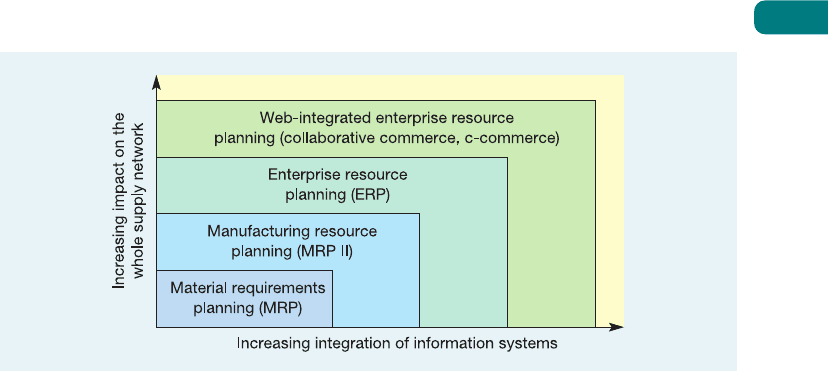
Manufacturing Resource Planning (MRP II) expanded out of MRP during the 1980s.
Again, it was a technology innovation that allowed the development. Local-area networks
(LANs, see Chapter 8), together with increasingly powerful desktop computers, allowed a
much higher degree of processing power and communication between different parts of
a business. Also MRP II’s extra sophistication allowed the forward modelling of ‘what-if ’
scenarios. The strength of MRP and MRP II lay always in the fact that it could explore the
consequences of any changes to what an operation was required to do. So, if demand changed,
the MRP system would calculate all the ‘knock-on’ effects and issue instructions accordingly.
This same principle also applies to ERP, but on a much wider basis. Enterprise resource
planning (ERP) has been defined as,
‘a complete enterprise wide business solution. The ERP system consists of software support
modules such as: marketing and sales, field service, product design and development, produc-
tion and inventory control, procurement, distribution, industrial facilities management, process
design and development, manufacturing, quality, human resources, finance and accounting,
and information services. Integration between the modules is stressed without the duplication
of information.’
2
Some authorities caution against taking a naïve view of ERP. Look at this view:
‘Enterprise resource planning software, or ERP, doesn’t live up to its acronym. Forget about
planning – it doesn’t do much of that – and forget about resource, [it is] a throwaway term.
But remember the enterprise part. This is ERP’s true ambition. It attempts to integrate all
departments and functions across a company onto a single computer system that can serve all
those different departments’ particular needs.’
3
So, ERP systems allow decisions and databases from all parts of the organization to be
integrated so that the consequences of decisions in one part of the organization are reflected
in the planning and control systems of the rest of the organization (see Fig. 14.3). ERP is
the equivalent of the organization’s central nervous system, sensing information about the
condition of different parts of the business and relaying the information to other parts of the
business that need it. The information is updated in real time by those who use it and yet is
always available to everyone connected to the ERP system.
Also, the potential of web-based communication has provided a further boost to ERP
development. Many companies have suppliers, customers and other businesses with whom
they collaborate who themselves have ERP-type systems. An obvious development is to allow
these systems to communicate. However, the technical, as well as organizational and strategic
consequences of this can be formidable. Nevertheless, many authorities believe that the true
value of ERP systems is only fully exploited when such web-integrated ERP (known by some
people as ‘collaborative commerce’, or c-commerce) becomes widely implemented.
Manufacturing Resource
Planning
Enterprise resource
planning
Web-integrated ERP
Chapter 14 Enterprise resource planning (ERP)
409
Figure 14.2 The development of ERP
M14A_SLAC0460_06_SE_C14A.QXD 10/20/09 9:46 Page 409
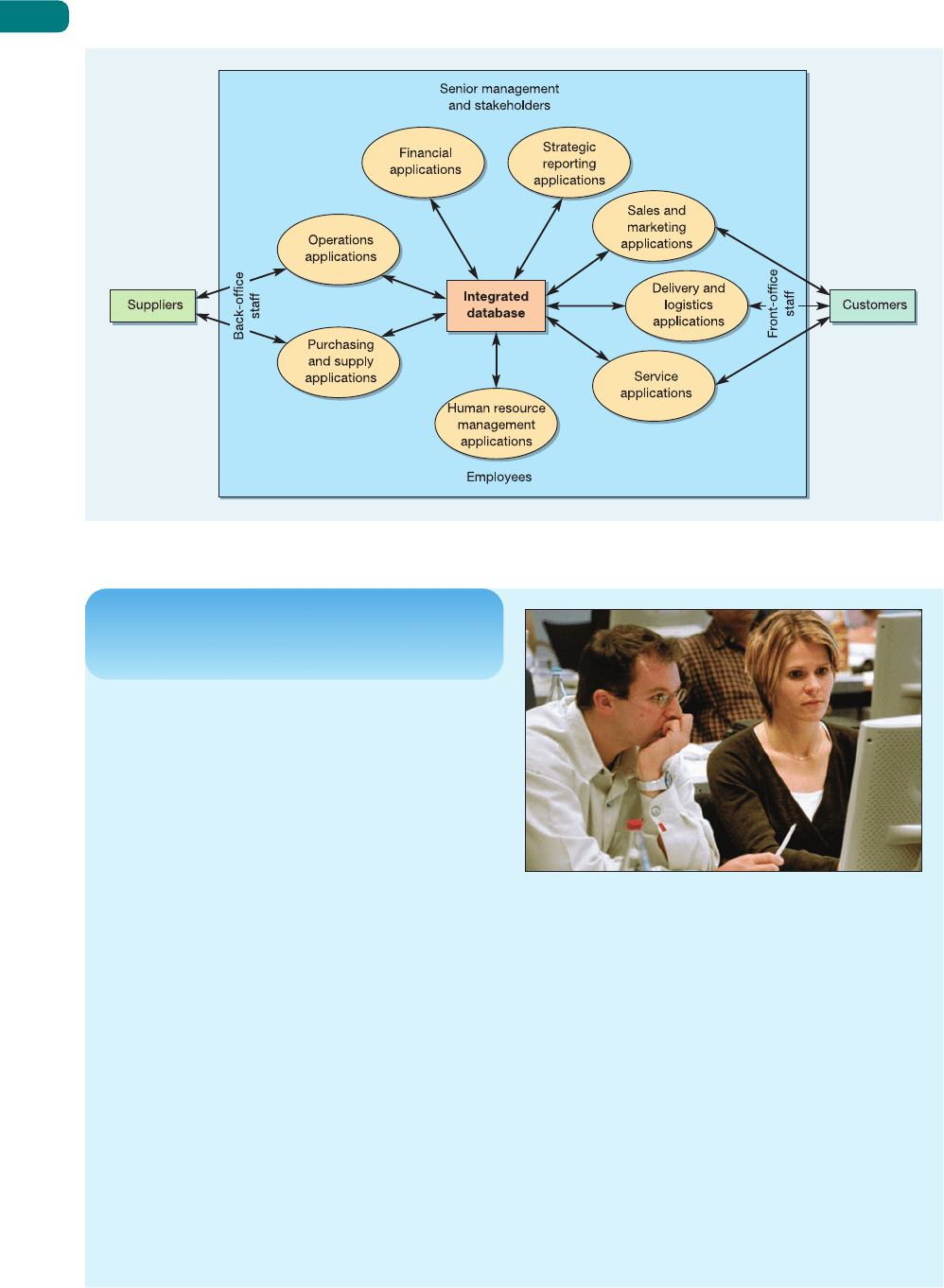
Part Three Planning and control
410
Figure 14.3 ERP integrates information from all parts of the organization
The largest European software company, based in
Walldorf, Germany, SAP’s growth over the years has
matched the popularity of the ERP systems which are
still the foundation of its success. Founded by five former
IBM engineers in 1972, SAP launched its ground-breaking
SAP R/1 system one year later. This was followed by SAP
R/2 in 1979 and R/3 in 1992. In 1999 SAP anticipated the
influence of the Internet on network integration with its
‘mySAP.com’ product. Now customers in more than
120 countries run SAP ‘business software’ applications.
These range, as the Company phrases it, from distinct
solutions addressing the needs of small businesses
and midsize companies to suite offerings for global
organizations. SAP defines ‘business software’ as
comprising enterprise resource planning and related
applications such as supply chain management, customer
relationship management, product life-cycle management,
and supplier relationship management.
SAP is well known for developing a network of
‘business partners’ to develop new products, sell its
‘solutions’, implement them into customers’ operations,
provide service, educate end users, and several other
activities. There are various categories of partnerships.
● Global Alliances – SAP global alliance partners are
themselves global leaders and are therefore strategic
partners with significant global presence. Membership
is by invitation only.
Short case
SAP and its partners
4
● Original equipment manufacturers (OEM) – This is for
independent software vendors who integrate SAP
technologies with their own products. OEM partners
may add on, bundle, host, or embed SAP software.
● Solution providers – These partners offer customized
solutions (a combination of business, technical, or
application expertise) that include SAP software.
● Complementary technology partners – These
partners provide complete, technically verified turnkey
(out-of-the-box) software solutions that extend and
add value to SAP solutions.
● Volume resellers – These partners resell all or part of
the SAP software portfolio and derive their primary
revenue from license sales.
● Authorized education – Partners are authorized by
SAP to provide official training and education services
to ensure that customers’ employees gain optimal
training.
Source: SAP
M14A_SLAC0460_06_SE_C14A.QXD 10/20/09 9:46 Page 410

The benefits of ERP
ERP is generally seen as having the potential to very significantly improve the performance of
many companies in many different sectors. This is partly because of the very much enhanced
visibility that information integration gives, but it is also a function of the discipline that
ERP demands. Yet this discipline is itself a ‘double-edged’ sword. On one hand, it ‘sharpens
up’ the management of every process within an organization, allowing best practice (or at
least common practice) to be implemented uniformly through the business. No longer will
individual idiosyncratic behaviour by one part of a company’s operations cause disruption
to all other processes. On the other hand, it is the rigidity of this discipline that is both diffi-
cult to achieve and (arguably) inappropriate for all parts of the business. Nevertheless, the
generally accepted benefits of ERP are usually held to be the following.
● Because software communicates across all functions, there is absolute visibility of what is
happening in all parts of the business.
● The discipline of forcing business-process-based changes (Chapters 1 and 18 look at busi-
ness process) is an effective mechanism for making all parts of the business more efficient.
● There is better ‘sense of control’ of operations that will form the basis for continuous
improvement (albeit within the confines of the common process structures).
● It enables far more sophisticated communication with customers, suppliers and other
business partners, often giving more accurate and timely information.
● It is capable of integrating whole supply chains including suppliers’ suppliers and customers’
customers.
In fact, although the integration of several databases lies at the heart of ERP’s power, it
is nonetheless difficult to achieve in practice. This is why ERP installation can be particularly
expensive. Attempting to get new systems and databases to talk to old (sometimes called legacy)
systems can be very problematic. Not surprisingly, many companies choose to replace most,
if not all, of their existing systems simultaneously. New common systems and relational data-
bases help to ensure the smooth transfer of data between different parts of the organization.
In addition to the integration of systems, ERP usually includes other features which make it
a powerful planning and control tool:
● It is based on a client–server architecture; that is, access to the information systems is open
to anyone whose computer is linked to central computers.
● It can include decision support facilities (see Chapter 8) which enable operations decision-
makers to include the latest company information.
● It is often linked to external extranet systems, such as the electronic data interchange
(EDI) systems, which are linked to the company’s supply chain partners.
● It can be interfaced with standard applications programs which are in common use by
most managers, such as spreadsheets etc.
● Often, ERP systems are able to operate on most common platforms such as Windows or
UNIX, or Linux.
Chapter 14 Enterprise resource planning (ERP)
411
In Chapter 10 we looked at the schedule for the
manufacture of a chicken salad sandwich. This
concentrated on the lead times for the ordering of the
ingredients and the manufacturing schedule for producing
the sandwiches during the afternoon and night-time
of each day for delivery during the evening and the
night-time, and the morning of the following day. But that
is only one half of the story, the half that is concerned
The life and times of a chicken
salad sandwich – part two
5
with planning and controlling the timing of events.
The other half concerns how the sandwich company
manages the quantity of ingredients to order, the quantity
of sandwiches to be made, and the whole chain of
implications for the whole company. In fact, this sandwich
company uses an ERP system that has at its core an
MRP II package. This MRP II system has the two normal
basic drivers of, first, a continually updated sales forecast,
and, second, a product structure database. In this case
the product structure and/or bill of materials is the ‘recipe’
for the sandwich, within the company this database is
called the ‘Recipe Management System’. The ‘recipe’ for
➔
M14A_SLAC0460_06_SE_C14A.QXD 10/20/09 9:46 Page 411
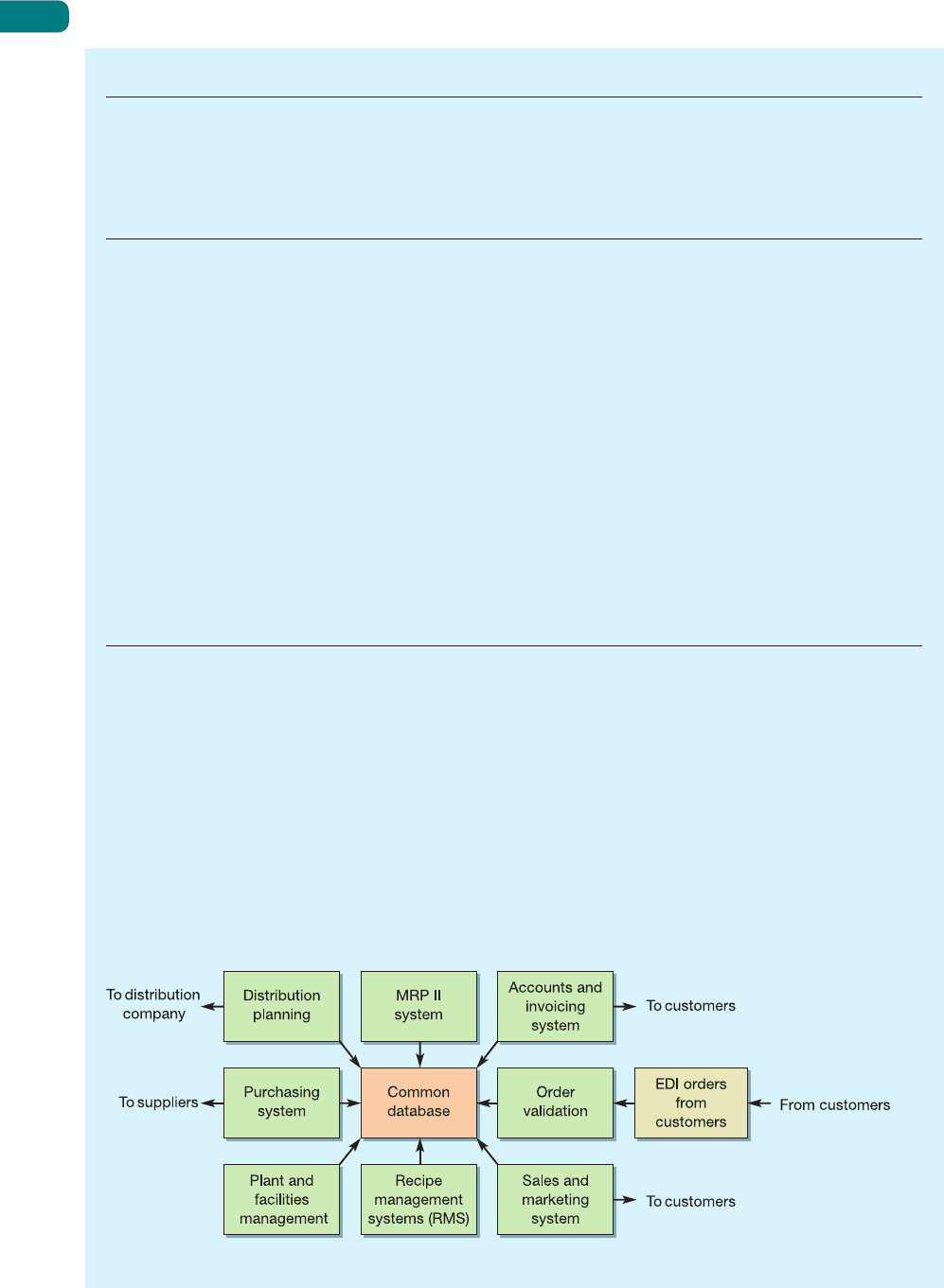
Part Three Planning and control
412
the chicken sandwich (its bill of materials), is shown in
Table 14.1.
Figure 14.4 shows the ERP system used by
this sandwich company. Orders are received from
customers electronically through the EDI system.
These orders are then checked through what the
company calls a Validation System that checks the
order against current product codes and expected
quantities to make sure that the customer has not
made any mistakes, such as forgetting to order some
products (this happens surprisingly often). After
validation the orders are transferred through the
central database to the MRP II system that performs
the main requirements breakdown. Based on these
requirements and forecasted requirements for the next
few days, orders are placed to the company’s suppliers
for raw materials and packaging. Simultaneously,
confirmation is sent to customers, accounts are updated,
staffing schedules are finalized for the next two weeks
(on a rolling basis), customers are invoiced, and all this
information is made available both to the customer’s
own ERP systems and the transportation company’s
planning system.
Interestingly, the company, like many others,
found it difficult to implement its ERP system. ‘It was
a far bigger job than we thought’, according to the
company’s operations director, ‘We had to change the
way we organized our processes so that they would fit
Table 14.1 Bill of Materials for a chicken salad sandwich
FUNCTION: MBIL MULTI-LEVEL BILL INQUIRY
PARENT: BTE80058 DESC: HE CHICKEN SALAD TRAY
RV: UM:EA RUNLT: 0 FIXED LT: 0
PLNR: LOU PLN POL: N DRWG: WA1882 LA
LEVEL PT C PARTIAL
1...5...10 USE SEQN COMPONENT T DESCRIPTION QTY UM
1 PACK 010 FTE80045 P H.E. CHICKENS 9 EA
2 ASSY 010 MBR–0032 P BREAD HARVESTE 2 SL
3 HRPR 010 RBR–0023 N BREAD HARVESTE .04545455 EA
2 ASSY 020 RDY–0001 N SPREAD BUTTER .006 KG
2 ASSY 030 RMA–0028 N MAYONNAISE MYB .01 KG
2 ASSY 040 MFP–0016 P CHICKEN FRESH .045 KG
3 HRPR 010 RFP–0008 N CHICKEN FRESH 1 KG
ASSY 050 MVF–0063 P TOMATO SLICE 4 3 SL
3 ALTI 010 RVF–0026 P TOMATOES PRE–S .007 KG
4 HRPR 010 RVF–0018 N TOMATOES 1 KG
2 ASSY 060 MVF–0059 P CUCUMBER SLICE 2 SL
3 ALTI 010 RVF–0027 P CUCUMBER SLICE .004 KG
4 TRAN 010 RVF–0017 N CUCUMBER 1 KG
2 ASSY 070 MVF–0073 P LETTUCE COS SL .02 KG
3 HRPR 010 RVF–0015 N LETTUCE COS 1 KG
2 ASSY 080 RPA–0070 N WEBB BASE GREY .00744 KG
2 ASSY 090 RPA–0071 N WEBB TOP WHITE .0116 KG
2 ASSY 100 RLA–0194 N LABEL SW H 1 EA
2 ASSY 110 RLA–0110 N STICKER NE 1 EA
1 PACK 010 RPA–0259 N SOT LABELL 1 EA
1 PACK 030 RPA–0170 N TRAY GREEN 1 EA
Figure 14.4 The ERP structure for the sandwich company
M14A_SLAC0460_06_SE_C14A.QXD 10/20/09 9:46 Page 412

ERP changes the way companies do business
Arguably the most significant issue in many a company’s decision to buy an off-the-shelf
ERP system is that of its compatibility with the company’s current business processes and
practices. The advice that is emerging from the companies that have adopted ERP (either
successfully or unsuccessfully) is that it is extremely important to make sure that their current
way of doing business will fit (or can be changed to fit) with a standard ERP package. In fact,
one of the most common reasons for companies to decide not to install ERP is that they
cannot reconcile the assumptions in the software of the ERP system with their core business
processes. If, as most businesses find, their current processes do not fit, they can do one of
two things. They could change their processes to fit the ERP package. Alternatively, they could
modify the software within the ERP package to fit their processes. Both of these options involve
costs and risks. Changing business practices that are working well will involve reorganization
costs as well as introducing the potential for errors to creep into the processes. Adapting the
software will both slow down the project and introduce potentially dangerous software ‘bugs’
into the system. It would also make it difficult to upgrade the software later on.
Why did companies invest in ERP?
If one accepts only some of the criticisms of ERP outlined in the critical commentary box,
it does pose the question as to why companies have invested such large amounts of money in
it. Partly it was the attraction of turning the company’s information systems into a ‘smooth
running and integrated machine’. The prospect of such organizational efficiency is attractive
to most managers, even if it does presuppose a very simplistic model of how organizations
work in practice. After a while, although organizations could now see the formidable prob-
lems in ERP implementation, the investments were justified on the basis that ‘even if we
gain no significant advantage by investing in ERP, we will be placed at a disadvantage by not
investing in it because all our competitors are doing so’. There is probably some truth in this;
sometimes businesses have to invest just to stand still.
Chapter 14 Enterprise resource planning (ERP)
413
Far from being the magic ingredient which allows operations to fully integrate all their informa-
tion, ERP is regarded by some as one of the most expensive ways of getting zero or even
negative return on investment. For example, the American chemicals giants, Dow Chemical,
spent almost half a billion dollars and seven years implementing an ERP system which became
outdated almost as soon as it was implemented. One company, FoxMeyer Drug, claimed that
the expense and problems which it encountered in implementing ERP eventually drove it
into bankruptcy. One problem is that ERP implementation is expensive. This is partly because
of the need to customize the system, understand its implications on the organization, and train
staff to use it. Spending on what some call the ERP ecosystem (consulting, hardware,
networking and complementary applications) has been estimated as being twice the spending
on the software itself. But it is not only the expense which has disillusioned many companies,
it is also the returns they have had for their investment. Some studies show that the vast
majority of companies implementing ERP are disappointed with the effect it has had on their
businesses. Certainly many companies find that they have to (sometimes fundamentally)
change the way they organize their operations in order to fit in with ERP systems. This
organizational impact of ERP (which has been described as the corporate equivalent of
root-canal work) can have a significantly disruptive effect on the organization’s operations.
Critical commentary
in with the ERP system that we bought. But that was
relatively easy compared to making sure that the system
integrated with our customers’, suppliers’ and distributors’
systems. Because some of these companies were also
implementing new systems at the time, it was like trying
to hit a moving target’. However, three years after the
start of implementation, the whole process was working
relatively smoothly.
M14A_SLAC0460_06_SE_C14A.QXD 10/20/09 9:46 Page 413
